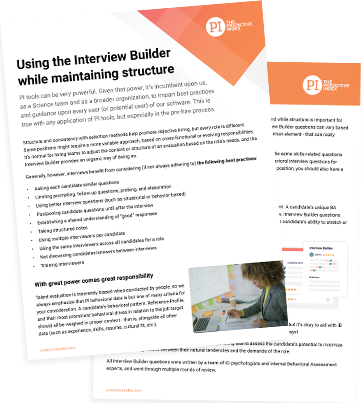Implementation by product
Your Predictive Index implementation
Your Predictive Index implementation
Implementation by product
Post-implementation best practices
Hire implementation

Below are some steps to help you get up and running with the features that are specific to Hire that would apply to anyone involved in recruiting.
Making the right hire is critical to your organization’s success. Increase your odds of placing the right people in the right roles by creating a world-class hiring process.
The whole person
It’s important to always remember that a job candidate is more than a list of experiences, education, and references on a piece of paper. To better understand their fit for a job, assess their behavioral drives and cognitive ability (head), their values and interests (heart), along with their knowledge, skills, and experience (briefcase).

Hire implementation steps
- Determine where Behavioral & Cognitive Assessments will go in your hiring process
- Plan when and how to use features and guides in Hire
- Create structured interviews
- Communicate to your hiring teams
Where should the PI Behavioral Assessment go in your hiring process?
You can apply the Behavioral Assessment at the point in your hiring process that makes the most sense for everyone involved. The following interactive demonstrates what it would look like for your organization to send the BA early vs. later:
Incorporating the PI Cognitive Assessment
The Predictive Index Cognitive Assessment measures a person’s general cognitive ability, and is one of the strongest indicators of job performance. It gives visibility into how quickly your candidates will onboard, learn the role and adapt to change. This provides you with confidence that you’re making data-driven decisions rather than relying on emotions or guesswork in your hiring process. You can view sample Cognitive Assessment questions here.
When you’re determining when and how to use the CA at your organization, keep in mind:
- It was built and validated exclusively for use in the workplace, and it provides insight into a person’s capacity to learn, adapt, and grasp new concepts.
- It does not measure IQ or previously acquired knowledge (e.g., job-specific knowledge), behaviors, or willingness to make an effort to learn new things. Rather, it indicates how fast an individual can be expected to acquire new knowledge.
- When combined with other selection criteria, including the Behavioral Assessment, resumes, and interviews, our Cognitive Assessment provides a powerful understanding of a candidate’s potential for success in a given role.
Planning when and how to use features and guides in Hire
Once you’ve decided where and when you’ll use the Behavioral and Cognitive Assessments, you need to determine which tools in the software you and your hiring teams will take advantage of as soon as a new role is posted. Work with your PI Partner to learn how to:
- Gain an understanding of the different ways to build a Job Target: PI Benchmark, Top Performer, and Collaborative target.
- Understand how to make the most of the Job Assessment.
- Create and gain alignment on Job Targets.
- Utilize the Job Ad Optimizer and Interview Builder.
- Communicate with candidates. Decide if you’re going to use the PI-generated email when sending assessments to candidates or if you’d like to customize it.
- Share Candidate Insights packets with the hiring team (view a sample here).
Creating structured interviews
Hiring great talent has become a critical art. Interviews play a pivotal role in finding the right person for the job, and are often your best opportunity for digging deeper, confirming behavioral traits and gaining reassurance about a candidate. Remember, applicants are interviewing you as well. Creating a smooth and delightful interview process benefits everyone involved.
A great interview tailors the experience to assess the needs of the job as well as the specialities of the candidate. This requires a clear understanding of the requirements of the role and an ability to gauge the fit of those job characteristics to your candidate.
A structured interview process is intended to create a consistent way to interview and assess candidates. When it comes time to review notes after all of the interviews have been completed, the team will be able to look at how each candidate fared in certain areas, avoiding costly mishires.
Structured interviews are more objective and ensure attention is focused on what’s important to the job. Our Interview Builder helps to streamline this part of the interview process and creates specific questions pertaining to a job’s requirements. It also helps save time in the event that you have multiple interviewers.
Communicating to your hiring teams

Create a communication plan for hiring teams that outlines what they can expect and what you expect from them. Familiarize them with the PI tools, methodology, and analytics you’ll be using in your new hiring process using PI.
